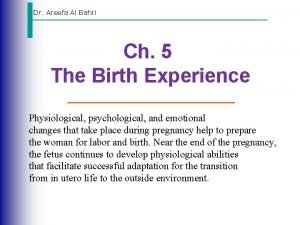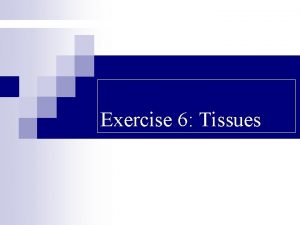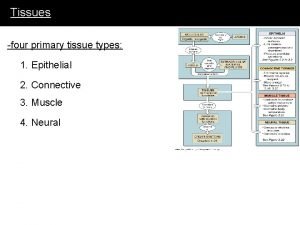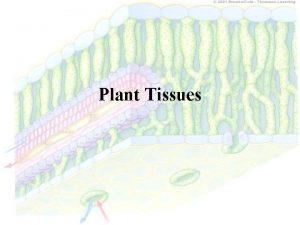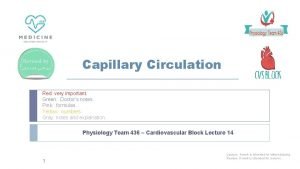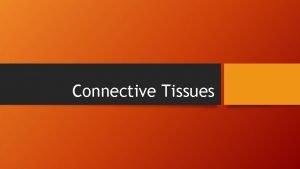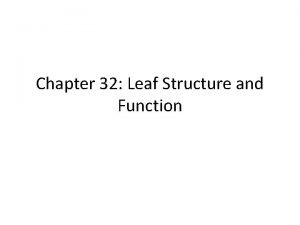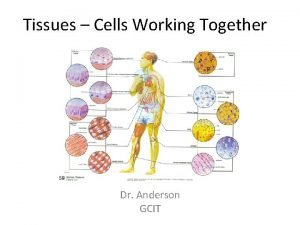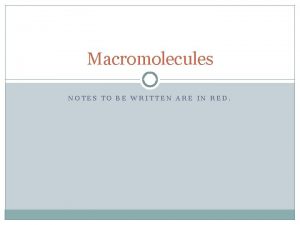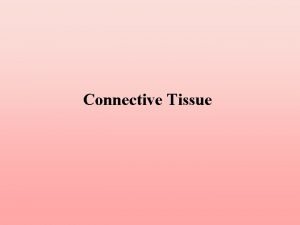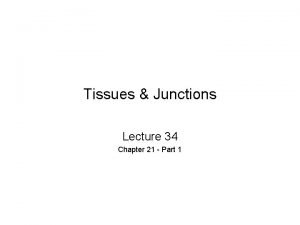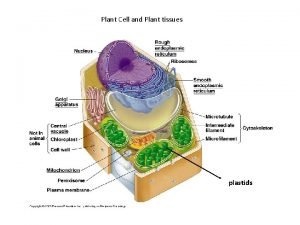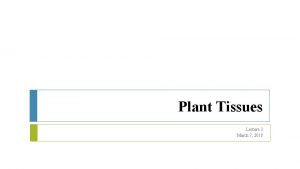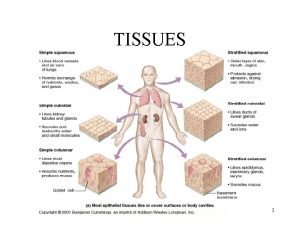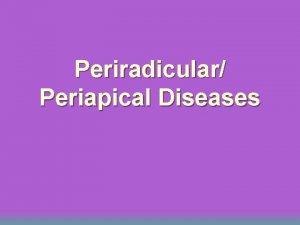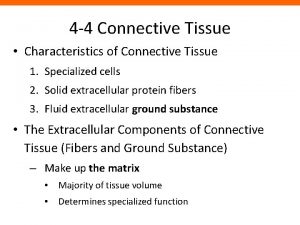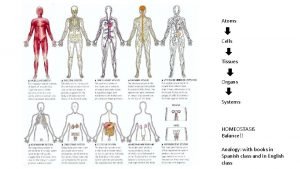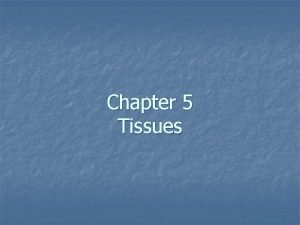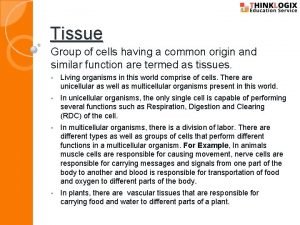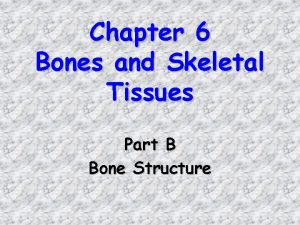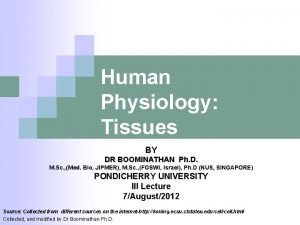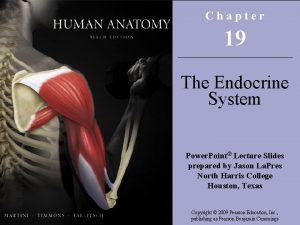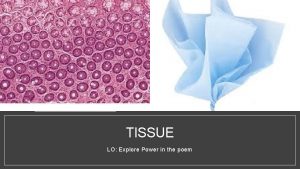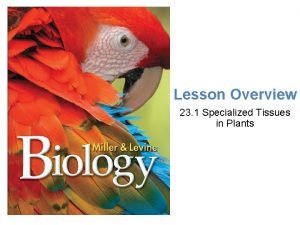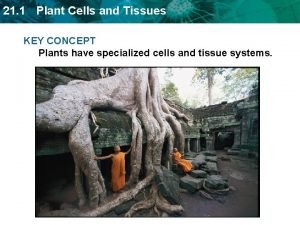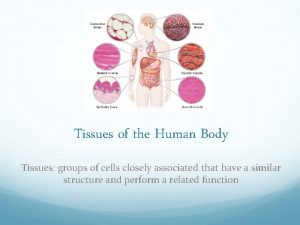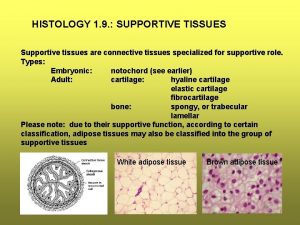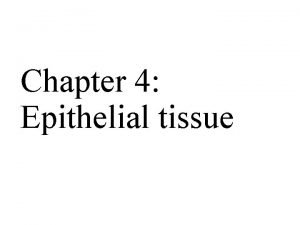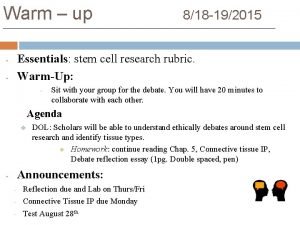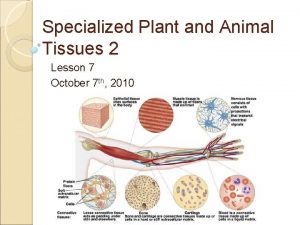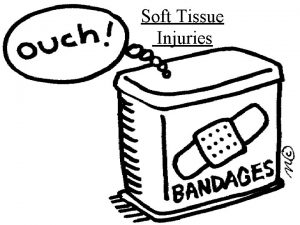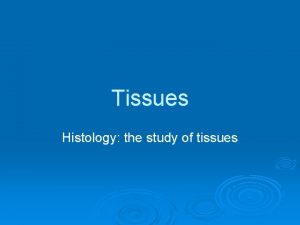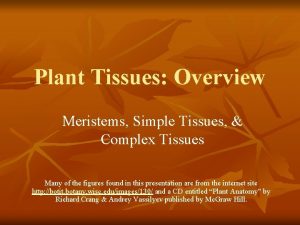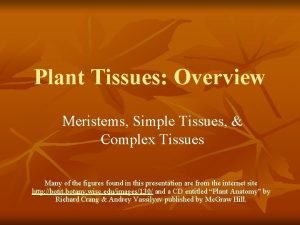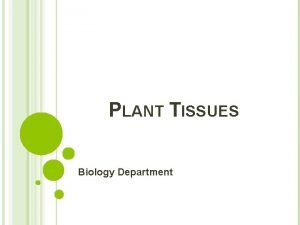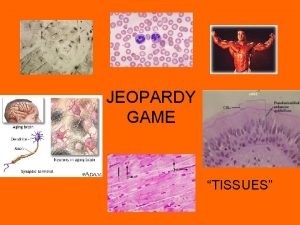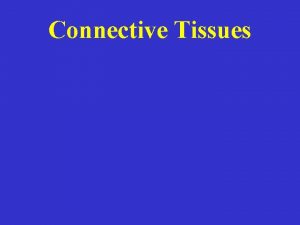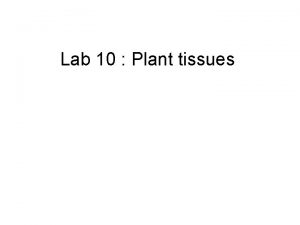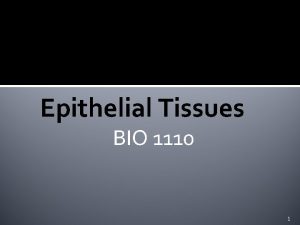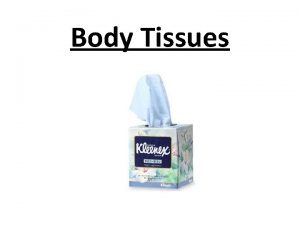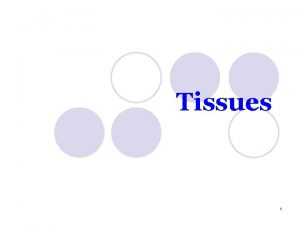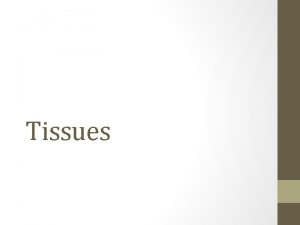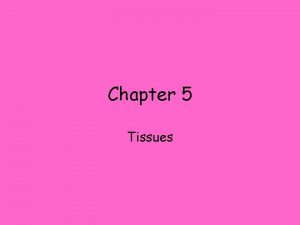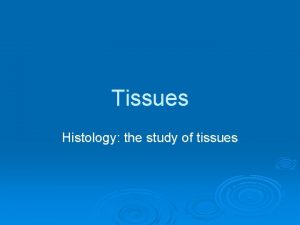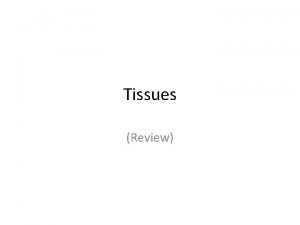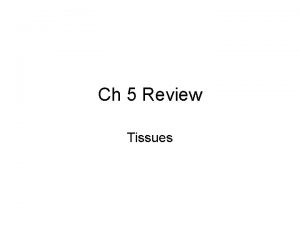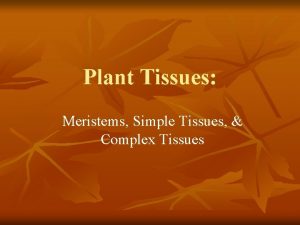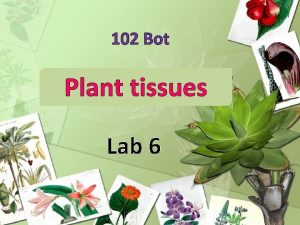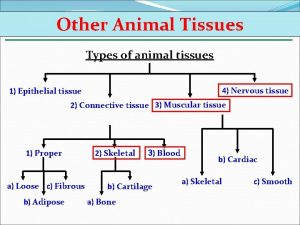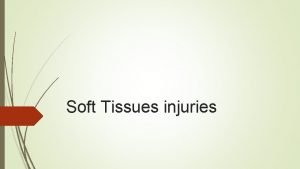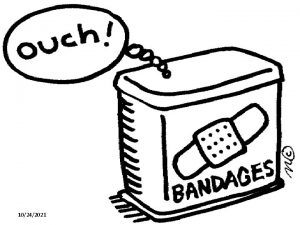Soft Tissues 2 Soft Tissues Other Soft Tissues
















































- Slides: 48

Soft Tissues (2) • • • Soft Tissues Other Soft Tissues Comparison of Behavior - Collagen and Elastic Skin Injuries Blood Vessels Arteries Veins Mechanical Properties Artherosclerosis Heart Valves Muscle Mechanical Behavior of Skeletal Muscle Mechanical Behavior of Smooth Muscle Structures of the Eye Biomateriali - Prof. O. Sbaizero

Soft Tissues • Besides the orthopedic soft tissues of ligaments, tendons, and cartilage, a number of other soft tissues exist in the body • These can be divided into collagen-rich tissues, elastic tissues, and others • The main function of collagen-rich tissues is load bearing • Examples of collagen-rich tissues Skin Cartilage of nose and ear Ligament and tendon are collagen-rich orthopedic soft tissues Biomateriali - Prof. O. Sbaizero

Other Soft Tissues • The main function of elastic tissues is restoration of the deformed state with minimum energy loss Examples of elastic tissues Blood vessels Muscle Heart valves • Examples of other tissues - Ocular lens - epithelial cells - Breast - fatty tissue - Organs: various tissue structures, including muscle and specialized cells Biomateriali - Prof. O. Sbaizero

Comparison of Behavior - Collagen and Elastic • Collagen is a viscoelastic tissue - Moderate hysteresis and stress relaxation - High modulus at small elongations - Characterized by tendon measurements • Elastin is almost perfectly elastic - Very small hysteresis and stress relaxation - Low modulus - Almost linear behavior - Characterized by measurements on ligamentum nuchae from which collagen has been removed See Figure 1 Biomateriali - Prof. O. Sbaizero

Biomateriali - Prof. O. Sbaizero

Biomateriali - Prof. O. Sbaizero

Biomateriali - Prof. O. Sbaizero

Skin • Largest organ, by mass, in the body which acts to contain all other structures • Felt-like structure with a high proportion collagen fibres randomly arranged in layers (Fig 2) • The mechanical behavior of skin is anisotropic, despite the random arrangement of the collagen fibres - Directional orientation of anisotropic properties is generally repeatable between individuals for various locations on the human body • Deformation behavior of skin (Fig 3) - Skin is extremely extensible under small loads despite the stiffness of collagen - why? Ans: The collagen fibers first straighten and then begin to stretch, at which point skin becomes much stiffer. Biomateriali - Prof. O. Sbaizero

-Under high stresses, the modulus of elasticity approaches that of tendon due to the collagen content • Skin not only performs load bearing functions, it also: Acts as a barrier to the outside environment, Germs, UV radiation, Provides a mechanism of heat exchange and temperature regulation, Acts to retain fluid in the body as well as to prevent absorption of fluid from the environment. Provides sensation throught nerve endings, Produces Vitamin D in response to sunlight • Skin is comprised of two layers - the inner dermis and the outer epidermis Biomateriali - Prof. O. Sbaizero

Electron micrographs of skin tissue showing relaxed (upper) and stretched (lower) state of collagen fibres. Fig. 2 Biomateriali - Prof. O. Sbaizero

Fig. 3 Biomateriali - Prof. O. Sbaizero

Biomateriali - Prof. O. Sbaizero

Biomateriali - Prof. O. Sbaizero

Biomateriali - Prof. O. Sbaizero

Biomateriali - Prof. O. Sbaizero

Biomateriali - Prof. O. Sbaizero

Biomateriali - Prof. O. Sbaizero

Injuries to the Skin • Burns - Burns result in direct damage to skin cells - Blistering occurs when plasma, the fluid portion of blood, collects between the dermis and the epidermis in the damaged area - If burns damage only the epidermis and the superficial portion of the dermis skin can regenerate completely - However, if damage extends below the superficial layer of the dermis then regrowth of the epidermis can only occur at the perimeter of the burn. This is when a skin graft is required. • Incisions and Lacerations - Incision - cut - Laceration - tear - Result in a separation of skin tissue - Generally heal by having the epidermis grow down into the cleft and then fill in the space, with dermis and epidermis regenerating - Involves deposition of substantial amounts of collagen - Scars are formed by oriented, layered collagen which no longer has the extension properties of healthy skin Biomateriali - Prof. O. Sbaizero

Blood Vessels (1) • One of the most important elastic tissues • Blood vessel walls consist of three layers (Fig 4) - Intima - longitudinally oriented structure - Media - circumferentially oriented structure - Adventitia - outer layer connected to surrounding tissue with fascia (general connective tissue) - The thickness and material components of each layer depends on the type of blood vessel and its function - Types of blood vessels *Arteries Elastic arteries - maintain blood pressure between heart beats Distribution arteries - distribute blood throughout body Arterioles - transport blood to capillary beds Capillaries (Fig 5) *Veins Venules - collect blood from capillary beds Small and medium veins - transport blood from tissues Large veins - return blood to heart Biomateriali - Prof. O. Sbaizero

Fig. 4 Biomateriali - Prof. O. Sbaizero

Fig. 5 Biomateriali - Prof. O. Sbaizero

Blood Vessels (2) • The major components of vessel walls are: - Smooth muscle cells - Elastin - Collagen • The proportion of each material depends on the type of vessel - Ratio of collagen to elastin Elastic arteries - 1: 2 Distribution arteries - 2: 1 Veins - 3: 1 • Blood vessels are lined with endothelial cells to provide a smooth surface Why is this important? Ans: - The smooth surface minimizes coagulation (clotting) and hemolysis (damage of red blood cells) - Reduces resistance to fluid flow - Minimizes turbulent flow Biomateriali - Prof. O. Sbaizero

Blood Vessels (3) • Comparison of veins and arteries Wall thickness and behavior (Fig 6) Arteries have thicker walls which maintain their shape when fluid pressure is reduced Veins have thinner walls which collapse under external tissue pressure Wall composition Veins have more collagen and less elastin than arteries of the same diameter Internal features (Fig 7) Veins have valves to prevent the back flow of blood during diastole and the pooling of blood in the lower extremities, arteries do not Biomateriali - Prof. O. Sbaizero

Fig. 6 Biomateriali - Prof. O. Sbaizero

Fig. 7 Biomateriali - Prof. O. Sbaizero

Arteries (1) Ans: Carry blood from the heart to the tissues -Elastic arteries - Largest arteries and closest to the heart (in network) - Act to maintain blood pressure between heart beats - Contain a large amount of elastin - how does this affect function? - Blood which is delivered from the heart causes the arteries to stretch - When the heart relaxes (dyastole) following contraction (systole), the elastic recoil of the arterial walls maintains the blood pressure until the next heart beat - Substantial amount of collagen in the adventitia (outer layer) may prevent the vessel from becoming overdilated on filling Biomateriali - Prof. O. Sbaizero

Arteries (2) - Distributing arteries - Large to medium sized arteries - Contain a large amount of smooth muscle cells to control distribution of blood to tissues - how does this affect function? Ans - As a region of the body requires more blood (oxygen and nutrients), the smooth muscle in the distributing arteries associated with this tissue relaxes and the vessels dilate - To maintain blood pressure, arteries in other regions typically constrict simultaneously through contraction of the smooth muscle - Smooth muscle cells are arranged helically around the circumference of the vessel in the media and longitudinally in the intima Biomateriali - Prof. O. Sbaizero

Veins (1) • Venules - Venules and the smallest veins (collecting veins) contain increasing amounts of smooth muscle with increasing vessel diameter • Small Veins - Media consists mostly of a layer of smooth muscle fibres - Intima consists mostly of endothelial cells • Large veins - Contain relatively little smooth muscle and instead has substantial amounts of collagen with some elastin - How does this affect vasodilation in large vessels? Ans: Limits the amount of vasodilation which can take place Biomateriali - Prof. O. Sbaizero

Veins (2) Veins contain about 75 % of the blood supply at any one time - The muscular control of vasodilation is very important in determining such parameters as cardiac output - Blood which remains in the veins when they have dilated is not returned to the heart as rapidly for recirculation Veins traveling through muscular regions of the body also respond to skeletal muscle contraction which acts to pump blood towards the heart Biomateriali - Prof. O. Sbaizero

Mechanical Properties of Blood Vessels Behave viscoelastically • Elastic and viscoelastic properties of arteries vary along the length of the arterial tree (Fig 8) - Composition and structural arrangement of fibres in walls also changes along arterial tree • Vessel walls are anisotropic with longitudinal and radial deformation behavior differing significantly - Due to the different arrangement of longitudinally, circumferentially, and helically arranged fibres • Blood vessels react under stress with a combination of the behaviors of collagen and elastin depending on the degree of stretch (Fig 9) - Smooth muscle contribution increase the resistance of the tissue to stretching - Passive smooth muscle is has a high degree of viscoelasticity and exhibits almost complete stress relaxation Active smooth muscle can resist deformation or further constrict vessels, but with the use of energy • The behavior of elastin dominates at low stresses and strains, while at higher levels of deformation the collagen dominates vessels become much stiffer Biomateriali - Prof. O. and Sbaizero (Fig 10)

Fig. 8 Biomateriali - Prof. O. Sbaizero

Fig. 9 Biomateriali - Prof. O. Sbaizero

Fig. 10 Biomateriali - Prof. O. Sbaizero

Atherosclerosis • Thickening and hardening of arterial walls characterized by formation of plaque-like lesions • Main underlying cause of - Ischemic heart disease (heart attacks) - Cerebrovascular disease (strokes) - Aortic aneurysms (Fig 11) • Damage to the intima results in fatty deposits which then become calcified and damage and weaken the entire vessel wall • The surface of the plaque can cause clots to form which are able to block arteries and result in tissue ischemia • The plaques can also grow to such an extent that they close of the passage through the vessel • Primarily affects elastic and distributing arteries Biomateriali - Prof. O. Sbaizero

Fig. 11 Biomateriali - Prof. O. Sbaizero

Heart Valves (1) • The heart contains four valves, at the entrance and exit of each of the two ventricles • The valves consist of two or three leaflets of connective tissue consisting mostly of elastin fibres attached to a fibrous ring surrounding the orifice • Diseases such as rhumatic fever can cause the leaflets to become inflamed - Healing of the leaflets involves deposition of substantial collagen which changes the mechanical properties - Valve leaflets become stiffer and shorter • Resulting Problems: Ans: During opening there is a poor flow of blood past the deformed leaflets When closed, the valves do not completely prevent leakage or regurgitation of blood Biomateriali - Prof. O. Sbaizero

Heart Valves (2) • Inlet and outlet valves differ in several ways: - Inlet (tricuspid and mitral valves) * Must withstand the full pressure of heart contraction without turning inside- out (umbrella effect) * Each leaflet is supported by chordae tendinae, cords of connective tissue which connect the valve to the inside surface of the heart (Fig 12) - Outlet (aortic and pulmonary valves) * Thinner leaflets than inlet valves * Do not have to withstand pressure of heart contraction - Valves open during contraction. No chordae tendinae present Biomateriali - Prof. O. Sbaizero

Fig. 12 Biomateriali - Prof. O. Sbaizero

Muscle (1) Three types of muscle exist - Skeletal muscle - voluntary muscle including all muscles which cause movement of the body - Smooth muscle - involuntary muscle which lines organs such as blood vessels and the digestive tract - Cardiac muscle - muscle of the heart Biomateriali - Prof. O. Sbaizero

Muscle (2) Biomateriali - Prof. O. Sbaizero

Muscle (3) • Of most interest from a biomaterials standpoint, with the possibility of replacement or interaction, is skeletal muscle • All muscles are active tissues and have different properties when they are and are not stimulated • Muscle consists solely of muscle cells and intervening connective tissue - Cells contract individually as a result of electrical stimulation from the nerves - The number of cells activated depends on the level of electrical stimulation - Contraction strength can be increased by * Increasing the frequency of stimulation for a single muscle cell to more than 10/sec - In skeletal muscle, once a critical frequency is reached the contractions cannot be distinguished from one another and the muscle is tetanized generates a maximal tension that is constant in time -Recruiting more muscle cells into the contracted state Biomateriali - Prof. O. Sbaizero

Mechanical Behavior of Skeletal Muscle • Passive muscle behaves as a viscoelastic material with low modulus - The stress-strain relationship depends on the rate of loading - Muscle will absorb energy during passive deformation * Reduces the energy transmitted to other structures • Actively contracting muscle has high stiffness and the ability to shorten itself to varying degrees • The passive and active components of muscle have been combined into a simplified model (Fig 13) - Modification of traditional mechanical model with addition of a contractile element - The contractile element extends freely in the passive state, so that behavior under these conditions is defined by the parallel viscoelastic elements - The series elasticity results from the intrinsic elasticity properties of the components Biomateriali - Prof. O. Sbaizero

Fig. 13 Biomateriali - Prof. O. Sbaizero

Mechanical Behavior of Smooth Muscle • An knowledge of smooth muscle function is necessary for the understanding of structures containing this material • Some smooth muscle (intestine) contracts spontaneously while the muscle in other structures (blood vessels) does not • In spontaneously contracting muscle, it is not possible to separate the active and passive mechanics of the structure - Contractile mechanism is not completely freed when electrical stimulation is removed • In smooth muscle structures that do not spontaneously contract, it is possible to separate these functions - more like skeletal muscle (Fig 14) • All smooth muscle undergoes rapid and almost complete stress relaxation in its "passive" state - Exhibits plastic behavior - moldable Biomateriali - Prof. O. Sbaizero

Biomateriali - Prof. O. Sbaizero Fig. 14

Structures of the Eye (1) • Cornea - Outer transparent portion at front of eye - Comprised of connective tissue, including collagen - Avascular Receives nutrients by diffusion from interior region of the eye Receives oxygen directly from the outside environment How is this of interest in materials design? Ans: Contact lenses must be gas permeable or worn only for short periods of time to allow oxygen to diffuse from the outside environment to the cornea - Clarity depends on constant removal of water from corneal tissue into the eye - Lens * Transparent structure further within the eye (Fig 15) comprised of epithelial cells * Relatively elastic bi-convex structure that is held in place by ligaments which control its curvature to allow both near and distant images to focus on the retina of the- Prof. eye. O. Sbaizero Biomateriali

Fig. 15 Biomateriali - Prof. O. Sbaizero

Structures of the Eye (2) • With age, the elasticity of the lens is reduced and the ability to change the focus length of the eye (accommodation) is impeded What effect does this have? Ans: - The individual has difficulty in changing the focus of the eye from near objects to far objects - Most often an individual becomes far sighted -- has difficulty focusing at near objects - This condition is termed presbyopia Biomateriali - Prof. O. Sbaizero
 Body tissues chapter 3 cells and tissues
Body tissues chapter 3 cells and tissues Cells form tissues. tissues form __________.
Cells form tissues. tissues form __________. Body tissues chapter 3 cells and tissues
Body tissues chapter 3 cells and tissues Body tissues chapter 3 cells and tissues
Body tissues chapter 3 cells and tissues Body tissues worksheet
Body tissues worksheet Fetal positions
Fetal positions Other initiated other repair
Other initiated other repair Chapter 3 cells and tissues figure 3-7
Chapter 3 cells and tissues figure 3-7 Exercise 6 tissues
Exercise 6 tissues What are the four primary tissue types
What are the four primary tissue types Monocot stem
Monocot stem Adipose epithelial tissue
Adipose epithelial tissue Gas exchange between tissues and capillaries
Gas exchange between tissues and capillaries What do all connective tissues have in common
What do all connective tissues have in common Cutaway drawing of leaf tissues
Cutaway drawing of leaf tissues Tissues working together
Tissues working together What macromolecule is a prominent part of animal tissues
What macromolecule is a prominent part of animal tissues Extracellular matrix of areolar connective tissue
Extracellular matrix of areolar connective tissue Dense connective tissue
Dense connective tissue What is tissue?
What is tissue? Plastid
Plastid 3 tissues of a plant
3 tissues of a plant Chapter 3 cells and tissues figure 3-7
Chapter 3 cells and tissues figure 3-7 Tissues are groups of similar cells working together to
Tissues are groups of similar cells working together to Periradicular disease
Periradicular disease Character of connective tissue
Character of connective tissue Tissues causes of civil war
Tissues causes of civil war Analogy of tissues
Analogy of tissues Four principal types of tissue
Four principal types of tissue Specialized connective tissue
Specialized connective tissue Meristematic tissues in plants are
Meristematic tissues in plants are Divisions of anatomy
Divisions of anatomy Identify the tissue
Identify the tissue Chapter 6 bones and skeletal tissues
Chapter 6 bones and skeletal tissues Tissue are grouped together to form various
Tissue are grouped together to form various A group of cells similar in structure and function
A group of cells similar in structure and function Goblet cells cilia and microvilli
Goblet cells cilia and microvilli Photosynthetic cells
Photosynthetic cells Endocrine tissues
Endocrine tissues Poem about tissues
Poem about tissues Tissues are groups of similar cells working together to
Tissues are groups of similar cells working together to Tissues
Tissues Plant tissues
Plant tissues Function of elastic connective tissue
Function of elastic connective tissue The circulatory system includes
The circulatory system includes Supportive tissues
Supportive tissues Stratified squamous epithelium function
Stratified squamous epithelium function Types of tissues
Types of tissues Tissues
Tissues





